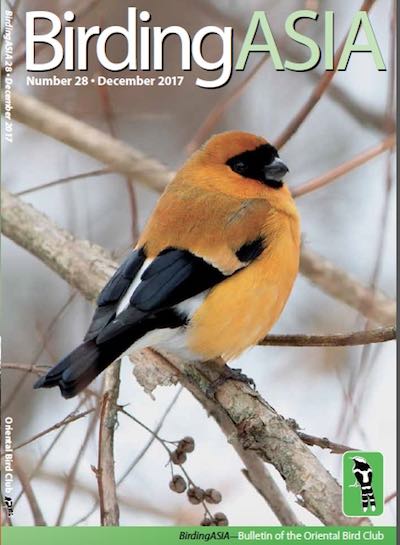The following is based on an article by OBC member Andy Mears that first appeared on the Birdguides website. Many thanks to Birdguides for granting the OBC permission to repost the article here. Vietnam is a bird-rich country bordered by China, Laos and Cambodia and strategically placed on the OBC region's eastern seaboard. From wintering Rufous-tailed Robins to breeding White-winged Magpies, the country has much to offer the travelling birder or interested reader.
Talk to non-birders about Vietnam and they are usually surprised to hear that it is a popular birding destination. In the same way that Ethiopia is perceived to be stark and famine-ridden, Vietnam is often viewed as war-torn and scarred. Neither perception is correct. Vietnam is in fact within an important area of endemism and retains some valuable tracts of rainforest that can easily be visited by birders today. Add to that accessible mountains and wetlands that host some of the rarest shorebirds on earth, and Vietnam becomes a stunning destination.
Birders visiting for a two- or three-week trip may well head to a series of well-known sites in the south after flying into Ho Chi Minh City (formerly Saigon). The upland areas of the Da Lat Plateau — including the wonderful Mount Lang Bian — are home to such quality species as Indochinese Green Magpie, Vietnamese Cutia and Collared Laughingthrush; and not far away sits the steamy, lowland forest of Cat Tien, which is perhaps Vietnam's flagship nature reserve.
Central areas are harder to reach and less well known. The near-mythical Crested Argus used to be a real possibility here for anyone willing to undertake an expedition but it is now all but gone, sad to say. Other areas could produce a suite of birds rarely seen, including Sooty Babbler and Limestone Warbler.
In the north after flying into Hanoi (the country's capital), birders may well visit the mist-shrouded forests of Tam Dao and other sites to search for parrotbills and cochoas. New on the birding map is Ba Be National Park, where White-eared Night Heron can be found; and over on the coast is the Ramsar site Xuan Thuy, an extensive tidal wetland with some very special passage visitors. Last but not least, they may travel just a couple of hours south from Hanoi to Cuc Phuong National Park.
Cuc Phuong is likely to be an important feature of any Vietnamese birding itinerary. It is a large reserve set in the limestone foothills of the Annamite Mountains. Accommodation, catering and birding trails can all be found at the remote Bong substation, which is 13 miles beyond the park headquarters; and areas immediately around the headquarters itself are also well worth birding. I spent five days in the park with fellow Brit birder Dennis Teece and I recount here just a few of our most interesting experiences.
At the Bong substation, there is simple bungalow accommodation for visitors and it's ideal for birders. The substation is set in a large forest clearing where the air is cool and the nights quite chilly. A small, simple restaurant provides lunches and evening meals, and we were also able to prepare a flask of hot water every evening ready for early-morning coffees the next day. So our days started before dawn with hot drinks and homemade flapjack and we would then be out to catch the first of the avian activity. Undisturbed, extensive rain forest is literally on the doorstep.
A great thing to do as the forest wakes up is to walk the level valley trail carefully looking ahead for thrushes on the path. Some patience was needed and waiting on the trail close to the substation paid off when we had nice views of a 'bobbing and weaving' White's Thrush and, on another day, a foraging Japanese Thrush. Others have also seen Black-breasted Thrush and Chinese Blackbird so this early-morning routine is well worth the effort and you never know what else might appear.
Walking the valley trail later, we sometimes heard Grey Peacock-pheasants giving their grating, staccato calls from way back in the trees. These are shy, forest-dwelling birds and we never did see one. They are a world away from the introduced Common Pheasants bred year on year and let loose into the British countryside. The true pheasants form a stunning family, with most species being difficult to see and displaying intricate and spectacular plumage. They are always a top target on an Asian birding trip along with the trogons, broadbills, pittas, hornbills and kingfishers. I've birded several areas that have the peacock-pheasant from northeast India to southern Thailand and have yet to lay eyes on one of these forest-floor ghosts.
As it gets lighter, the forest starts to come to life. Early morning is still a good time to find skulkers on or close to trails, however, and it also gets you out before any noisy tourists. We spent plenty of time on the loop trail and found that one section was a favourite area for one particular Bar-bellied Pitta. We saw this bird, a male, on several days and he almost seemed to get used to us hanging around. This was luxury for the pitta connoisseur and what a bird it is; out of the same box as Gurney's and Banded Pittas, Bar-bellied is an Indo-Chinese endemic and the male a spectacular mix of blue, yellow, black, green and turquoise.
In this same area, we had a brief view of what appeared to be a Chinese Thrush in some dense trail-side shrubs. This species is certainly a possibility at Cuc Phuong and it was frustrating to miss out on definitive views. Blue Whistling-thrushes were also seen a couple of times, keeping the thrush count high.
As I entered the forest on the loop trail one morning, a movement close by caught my eye. We carefully waited beside a large tangle and peered in hoping for any sign of a bird. After a minute or two, a rufous sliver of wing could be seen, which turned out to be part of a small robin. This was a bird neither of us had seen before and we patiently tried to paste together a full mental image. Eventually it walked out into an open patch and hopped across, with a nervous gait and some tail flicking. The rufous wings and tail and distinct scalloped breast pattern meant Rufous-tailed Robin, no doubt a wintering bird. Another movement and another small bundle of feathers hopped into the clearing. With a supercilium to end all supercilia, and the most minimal of tails, there was no mistaking this guy, an Asian Stubtail; a tiny but spectacular warbler and another new bird for us. What a great little tangle!
Perhaps the main focus of the Bong area is the grid. This is a lovely patch of rich forest, criss-crossed by narrow concrete paths. You can walk nice and quietly, and check round every corner with care hoping for a ground bird caught off guard. We spent long periods in the grid scanning the canopy, the understory and the ground, and working through any mixed flocks we encountered as best we could. The back of the grid was a particularly quiet area and time spent here revealed Blue-rumped and more Bar-bellied Pittas, plus Limestone Wren-babblers. The Blue-rumpeds were a devil to see and only gave the briefest of glimpses after we spent long periods staking them out. Often their subdued 'teu' call was all that gave them away even when they were very close. The babblers were vocal and active, and much easier to connect with as they bounced around the limestone outcrops.
Up in the canopy, the grid was alive with birds. Fairy Bluebirds, Paradise Flycatchers, Blue-winged Leafbirds and a multitude of other species were regularly seen. A few Silver-breasted Broadbills showed well, very special birds that quietly occupy a mid-canopy niche. We only heard Long-tailed Broadbills but they're around in the area and can be seen with luck.
Warblers were seen in numbers and presented many identification conundrums. Up in the canopy, views were often brief and incomplete. The birds moved quickly and rarely could all their features be seen. Experience here makes a huge difference, but neither of us had studied the Asian Phylloscs in depth other than a range of treasured birds seen in the UK and a handful of species seen on a few other foreign trips. Arctic Warblers were something of a relief. They were fairly common and tended to call allowing a quick ID. We realised that Blyth's Leaf Warbler fed like a nuthatch and with just a few supporting features seen, we could name these with confidence. Other warblers that we confirmed were Eastern Crowned, Grey-crowned, Bianchi's, Kloss's Leaf, Yellow-bellied and Yellow-browed; but I wonder what we missed.
After much perseverance, we eventually clinched views of Cuc Phuong's third pitta species, the elusive Eared Pitta. We'd been hearing these birds regularly on the loop trail, an eerie, double-whistle uttered most commonly at dawn and dusk. They are shy birds, however, with an unhelpful habit of freezing if they spot an intruder. Their cryptic plumage then renders them all but invisible and I suspect we sometimes overlooked birds in full view. Eventually, we spotted dry leaves being tossed some way up an open slope and there was a pair, quietly feeding together in the lee of some limestone crags.
I haven't mentioned a host of other species we saw and every birding group that visits sees a different set of species. Anything between a couple of days and a week could be spent productively working this fantastic area and anyone visiting will come away with treasured memories of some classic Oriental forest birding. Andy MearsFebruary 2015

























